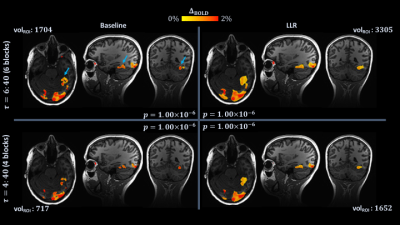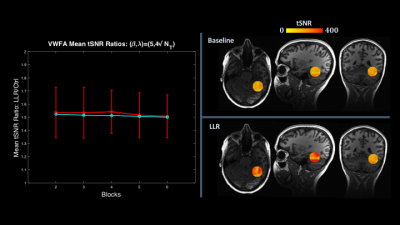Nolan Meyer1, Norbert G Campeau2, David F Black2, Kirk M Welker2, Erin Gray2, Daehun Kang2, MyungHo In2, John Huston2, Yunhong Shu2, Matt A Bernstein2, and Joshua D Trzasko2
1Mayo Clinic Graduate School of Biomedical Sciences, Rochester, MN, United States, 2Radiology, Mayo Clinic, Rochester, MN, United States
1Mayo Clinic Graduate School of Biomedical Sciences, Rochester, MN, United States, 2Radiology, Mayo Clinic, Rochester, MN, United States
Locally low-rank denoising of complex-valued fMRI data preceding analysis enables preservation of acceptable statistical confidence in localizing verbal activation following truncation of activity blocks from a task functional exam.

Figure 2.
Single subject (1) maps for six and four task blocks, with $$$p$$$ held
fixed at $$$1\times{10}^{-6}$$$ (full scans: $$$180$$$ degrees of freedom $$$[DOF]$$$, $$$t=5.07$$$; truncated scans: $$$120$$$ $$$DOF$$$,$$$t=5.16$$$). Maps are identically
slice-locked to localize the visual word form area (VWFA; blue arrows, top
left). At top left, full scan, control; top right, full scan, denoised; bottom
left, truncated scan, control; bottom right, truncated scan, denoised. Volumes
of active voxels within an ROI encompassing the VWFA are overlain (volROI).

Figure 1. At
left, plot in red of VWFA ROI-specific ratios of LLR to control group mean tSNR with
error bars showing standard deviation, with overlain plot of whole-brain mean tSNR
ratios in cyan. At right, an individual subject (from Figures 2-3) example of
an ROI enveloping the visual word form area used for mean tSNR and
for cluster volume tracking in Figure 2. LLR significantly increases mean tSNR both
in the VWFA ROI and globally.
